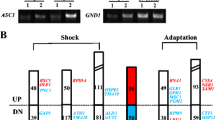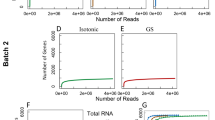Abstract
The aim of this study is to explore the effects of heat stresses on global gene expression profiles and to identify the candidate genes for the heat stress response in commercial baker’s yeast (Saccharomyces cerevisiae) by using microarray technology and comparative statistical data analyses. The data from all hybridizations and array normalization were analyzed using the GeneSpringGX 12.1 (Agilent) and the R 2.15.2 program language. In the analysis, all required statistical methods were performed comparatively. For the normalization step, among alternatives, the RMA (Robust Microarray Analysis) results were used. To determine differentially expressed genes under heat stress treatments, the fold-change and the hypothesis testing approaches were executed under various cut-off values via different multiple testing procedures then the up/down regulated probes were functionally categorized via the PAMSAM clustering. The results of the analysis concluded that the transcriptome changes under the heat shock. Moreover, the temperature-shift stress treatments show that the number of differentially up-regulated genes among the heat shock proteins and transcription factors changed significantly. Finally, the change in temperature is one of the important environmental conditions affecting propagation and industrial application of baker’s yeast. This study statistically analyzes this affect via one-channel microarray data.




Similar content being viewed by others
References
Akal T, Purutçuoğlu V, Weber GW (2016) Robust background normalization method for one-channel microarrays. Turk J Biochem. doi:10.1515/tjb-2016-0231
Baghel A, Jain V (2016) Shadow removal using YCBCR and k-means clustering. IJCA 134:21–26
Beskow S, de Mello CR, Vargas MM, Correa LDL, Caldeira TL, Duraes MF, de Aguiar MS (2016) Artificial intelligence techniques coupled with seasonality measures for hydrological regionalization of Q 90 under Brazilian conditions. J Hydrol 541:1406–1419
Boy-Marcotte E, Lagniel G, Perrot M, Bussereau F, Boudsocq A, Jacquet M, Labarre J (1999) The heat shock response in yeast: differential regulations and contributions of the Msn2p/Msn4p and Hsf1p regulons. Mol Microbiol 33:274–283
Charrad M, Ghazzali N, Boiteau V, Niknafs A (2014) NbClust: an R package for determining the relevant number of clusters in a data set. J Stat Softw 61:1–36
Chomczynski P, Sacchi N (1987) Single-step method of RNA isolation by acid guanidinium thiocyanate-phenol-chloroform extraction. Anal Biochem 162:156–159
Cope LM, Irizarry RA, Jaffee HA, Wu Z, Speed TP (2004) A benchmark for Affymetrix GeneChip expression measures. Bioinformatics 20:323–331
Dittrich T, Wobus M, Qiao W, Zandstra PW, Bornhauser M (2015) Cell-cell communication networks propose a modulation of the hematopoietic stem cell niche by invading breast carcinoma cells. J Bone Marrow Res 3:160
Eastmond DL, Nelson HCM (2006) Genome-wide analysis reveals new roles for the activation domains of the Saccharomyces cerevisiae heat shock transcription factor (Hsf1) during the transient heat shock response. J Biol Chem 281:32909–32921
Everitt B, Hothorn T (2011) An introduction to applied multivariate analysis with R. Springer, New York
Ewens W, Grant G (2005) Statistical methods in bioinformatics: an introduction. Springer, New York
Gentleman R, Irizarry RA, Carey WJ, Dudoit S, Huber W (2005) Bioinformatics and computational biology solutions using R and bioconductor. Springer, New York
Hein AK, Richardson S, Causton HC, Ambler GK, Green PJ (2005) BGX: a fully Bayesian integrated approach to the analysis of Affymetrix GeneChip data. Biostatistics 6:349–373
Herrero E, Ros J, Belli G, Cabiscol E (2008) Redox control and oxidative stress in yeast cells. BBA Gen Subjects 1780:1217–1235
Hirasawa T, Furusawa C, Shimizu H (2010) Saccharomyces cerevisiae and DNA microarray analyses: what did we learn from it for a better understanding and exploitation of yeast biotechnology? Appl Microbiol Biot 87:391–400
Hoffmann A, Ebert T, Klöting N, Dokas J, Jeromin F, Jessnitzer B, Burkhardt R, Fasshauer M, Kralisch S (2016) Leptin dose-dependently decreases atherosclerosis by attenuation of hypercholesterolemia and induction of adiponectin. BBA Mol Basis Dis 1862:113–120
Hohmann S, Mager WH (1997) Yeast stress responses. Chapman and Hall, New York
Hohmann S, Mager WH (2003) Yeast stress responses. Chapman and Hall, New York
Hubbell E, Liu WM, Mui R (2002) Robust estimators for expression analysis. Bioinformatics 18:1585–1592
Irizarry RA, Hobbs B, Collin F, Beazer-Barclay YD, Antonellis KJ, Scherf U, Speed TP (2003) Exploration, normalization, and summaries of high density oligonucleotide array probe level data. Biostatistics 4:249–264
Johnson RA, Wichern DW (2007) Applied multivariate statistical analysis. Pearson Prentice Hall, Upper Saddle River
Kaufman L, Rousseeuw PJ (2005) Findings groups in data, an introduction to cluster analysis. Wiley, New York
Küçükkülahlı E, Erdoğmuş P, Polat K (2016) Brain MRI segmentation based on different clustering algorithms. IJCA 155:37–40
Kutner MH, Nachtsheim CJ, Neter J, Li W (2005) Applied linear statistical models. McGraw-Hill, Boston
Lee ML (2004) Analysis of microarray gene expression data. Kluwer Academic Publishers, Boston
Li C, Wong W (2001) Model-based analysis of oligonucleotide arrays: expression index computation and outlier detection. Proc Natl Acad Sci USA 98:31–36
Li W, Meyer CA, Liu XS (2005) A hidden Markov model for analyzing ChIP-chip experiments on genome tiling arrays and its application to p53 binding sequences. Bioinformatics 21:i274–i282
Li J, Kluiver J, Osinga J, Westers H, van Werkhoven MB, Seelen M, Sijmons RH, van den Berg A, Kok K (2016) Functional studieson primary tubular epithelial cells indicate a tumor suppressor role of SETD2 in clear cell renal cell carcinoma. Neoplasia 18:339–346
Lin KP, Chang HF, Chen TL, Lu YM, Wang CH (2016) Intuitionistic fuzzy C-regression by using least squares support vector regression. Expert Syst Appl 64:296–304
Lindquist S, Craig EA (1988) The heat-shock proteins. Annu Rev Genet 22:631–677
MacIntyre DA, ChanDiramani M, Lee YS, Kindinger L, Smith A, Angelopoulos N, Lehne B, Arulkumaran S, Brown R, Teoh TG, Holmes E, Nicoholson JK, Marchesi JR, Bennett PR (2015) The vaginal microbiome during pregnancy and the posrpartum period in a European population. Sci Rep 5:8988
Maechler M (2016) Finding groups in data: cluster analysis extended Rousseeuw et al. R package version 2.4
Mai K, Zhang Q (2016) Identification of biomarkers for predicting the overall survival of ovarian cancer patients: a sparse group lasso approach. Int J Stat Probab 5:57
Mantione KJ, Kream RM, Kuzelova H, Ptacek R, Raboch J, Samuel JM, Stefano GB (2014) Comparing bioinformatic gene expression profiling methods: microarray and RNA-SEq. Med Sci Monit Basic Res 20:138
Martinez-Pastor MT, Marchler G, Schüller C, Marchler-Bauer A, Ruis H, Estruch F (1996) The Saccharomyces cerevisiae zinc finger proteins msn2p and msn4p are required for transcriptional induction through the stress response element (STRE). EMBO J 15:2227–2235
McLachlan GJ (2004) Analyzing microarray gene expression data. Wiley, Hoboken
Milo M, Fazelit A, Niranjan M, Lawrence ND (2003) A probabilistic model for the extraction of expression levels from oligonucleotide arrays. Biochem Soc Trans 31:1510–1512
Monti S, Tamayo P, Mesirov J, Golub T (2003) Consensus clustering: a resampling-based method for class discovery and visualization of gene expression microarray data. Mach Learn 52:91–118
Panadero J, Randez-Gil F, Prieto JA (2005) Validation of a flour-free model dough system for throughput studies of baker’s yeast. Appl Environ Microbiol 71:1142–1147
Purutçuoğlu V (2012) Robust gene expression index. Math Probl Eng. doi:10.1155/2011/182758
Purutçuoğlu V, Wit E (2007) FGX: a frequentist gene expression index for Affymetrix arrays. Biostatistics 8:433–437
Radujkovic A, Dietrich S, Andrulis M, Benner A, Longerich T, Pellagatti A, Nanda K, Giese T, Germing U, Baldus S, Boultwood J, Ho AD, Dreger P, Luft T (2016) Expression of CDKN1C in the bone marrow of patients with myelodysplastic syndrome and secondary acute myeloid leukemia is associated with poor survival after conventional chemotherapy. Int J Cancer 139:1402–1413
Sekula MN (2015) OptCluster: an R package for determining the optimal clustering algorithm and optimal number of clusters. Dissertation, University of Louisville
Stekel D (2003) Microarray bioinformatics. Cambridge University Press, Cambridge
Stuhlmüller BA (2016) SAT0004 genomic stratification by HLA-DRB4 expression identifies innate and adaptive immune patterns as differential predictors of response to methotrexate in rheumatoid arthritis. Ann Rheum Dis 75:665–665
Watanabe Y, Irie K, Matsumoto K (1995) Yeast RLM1 encodes a serum response factor-like protein that may function downstream of the Mpk1 (Slt2) mitogen-activated protein kinase pathway. Mol Cell Biol 15:5740–5749
Wiederrecht G, Seto D, Parker CS (1988) Isolation of the gene encoding the S.cerevisiae heat shock transcription factor. Cell 54:841–853
Wilkerson M, Waltman P (2013) ConsensusClusterPlus R package version 1.16.0
Wit E, McClure J (2004) Statistics for microarrays: design, analysis and inference. Wiley, Chichester
Yadav KK, Rajasekharan R (2016) Microarray data analyses of yeast RNA Pol I subunit RPA12 deletion strain. Genom Data 8:104–105
Ye SQ (2008) Bioinformatics a practical approach. Chapman and Hall/CRC, Boca Raton
Yılmaz R, Akça O, Baloğlu MC, Öz MT, Öktem HA, Yücel M (2012) Optimization of yeast (saccharomyces cerevisiae) RNA isolation method for real-time quantitative PCR and microarray analysis. Afr J Biotechnol 11:1046–1053
Acknowledgements
The authors would like to thank Prof. Dr. Meral Yücel (Department of Biological Sciences, Middle East Technical University) and Assoc. Prof. Dr. Mehmet Cengiz Baloğlu (Department of Bioengineering, Kastamonu University) for their valuable contributions for this research. Moreover, the authors would like to thank Sean C. Lawrie (Michigan State University) for his friendly support in the improvement of the language and the anonymous referees for their valuable comments which scientifically improve the quality of our paper.
Author information
Authors and Affiliations
Corresponding author
Ethics declarations
Conflict of interest
Duygu Varol declares that she has no conflict of interest. Vilda Purutçuoğlu declares that she has no conflict of interest. Remziye Yılmaz declares that she has no conflict of interest.
Ethical approval
This article does not contain any studies with human participants or animals performed by any of the authors.
Rights and permissions
About this article
Cite this article
Varol, D., Purutçuoğlu, V. & Yılmaz, R. Transcriptomic analysis of the heat stress response for a commercial baker’s yeast Saccharomyces cerevisiae . Genes Genom 40, 137–150 (2018). https://doi.org/10.1007/s13258-017-0616-6
Received:
Accepted:
Published:
Issue Date:
DOI: https://doi.org/10.1007/s13258-017-0616-6




